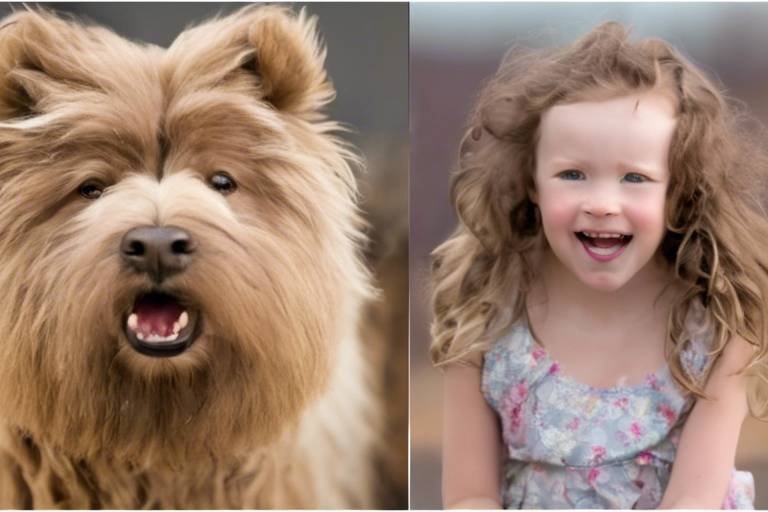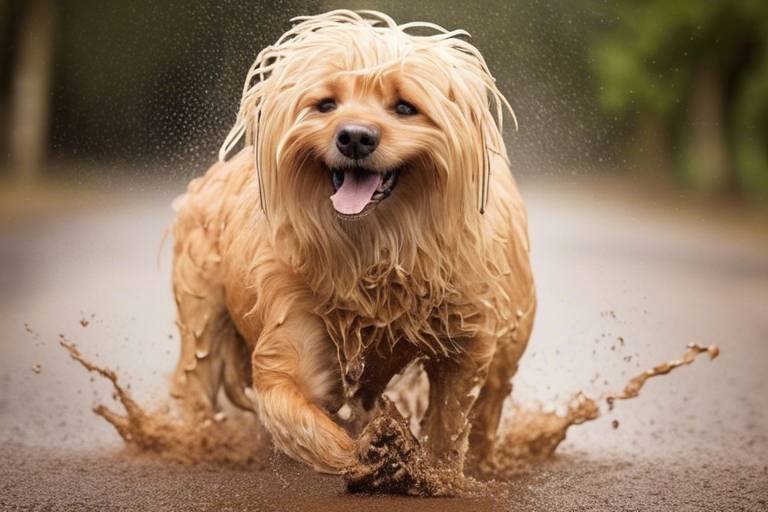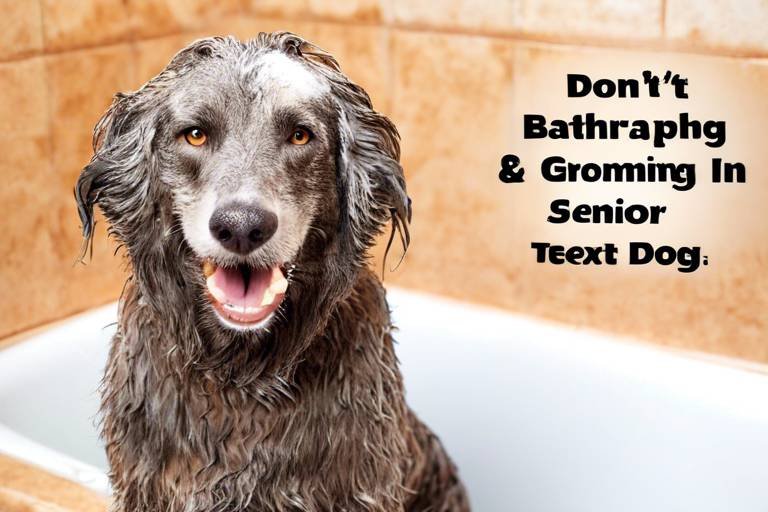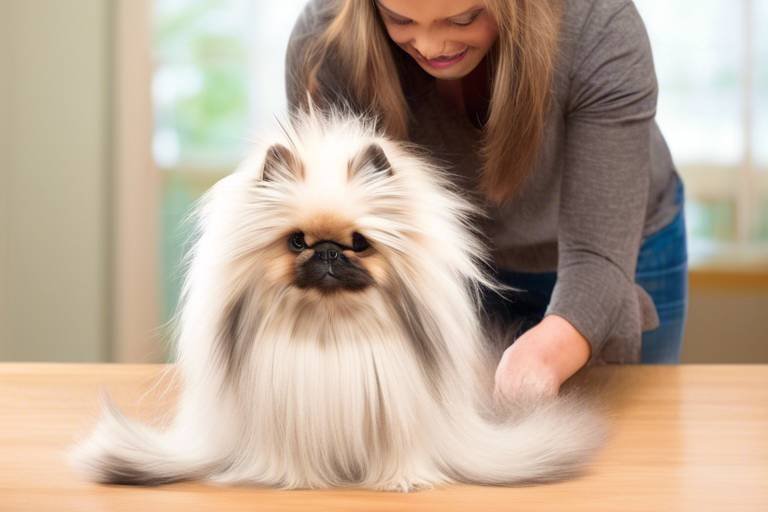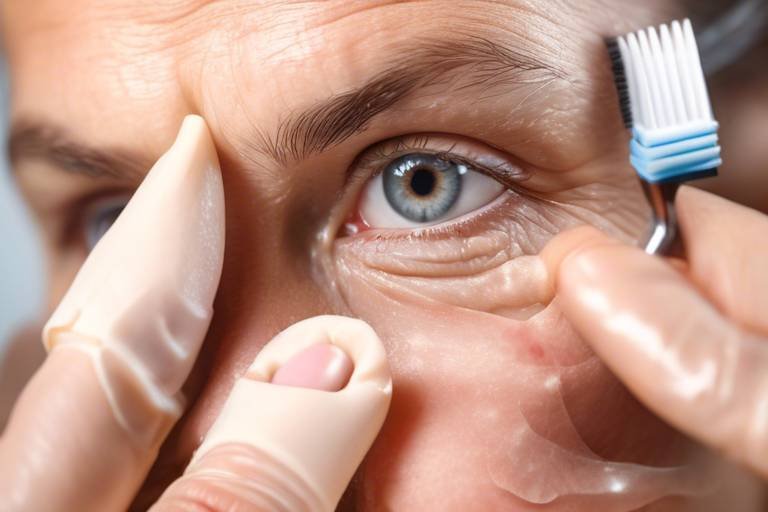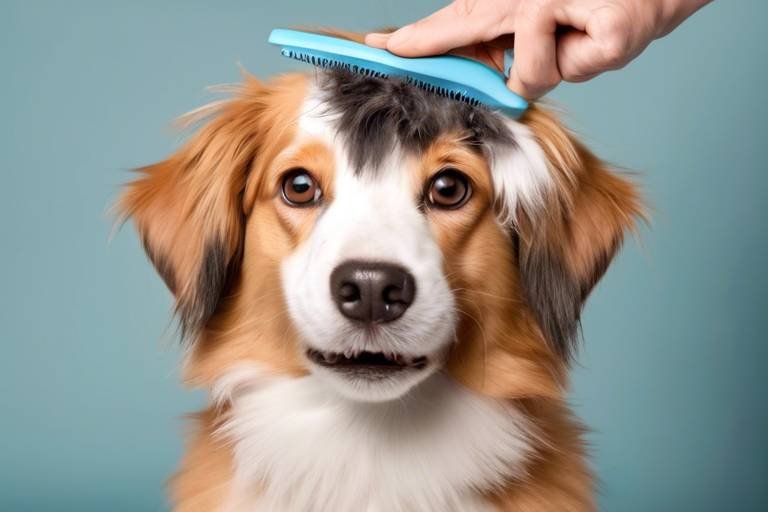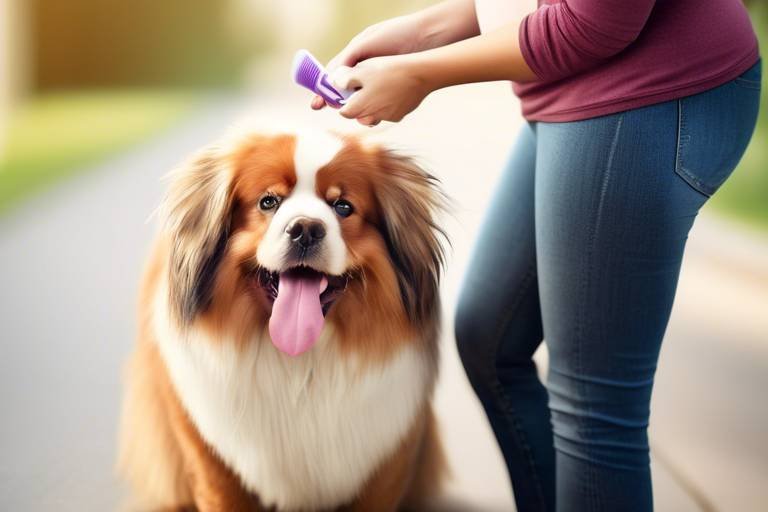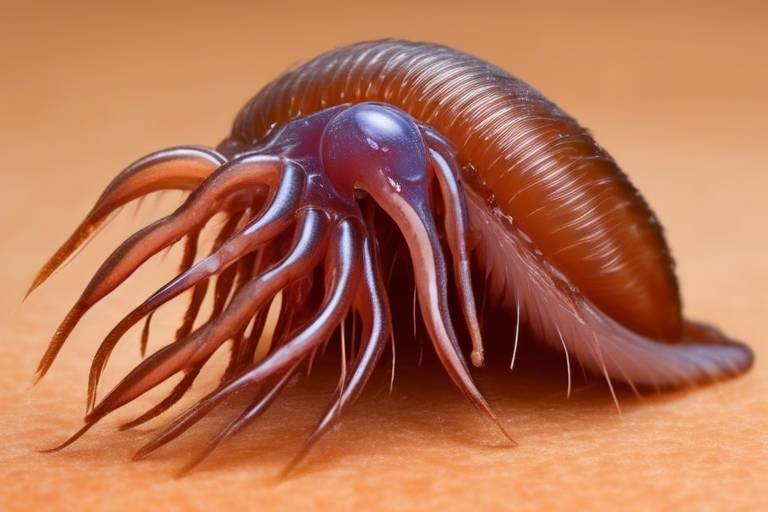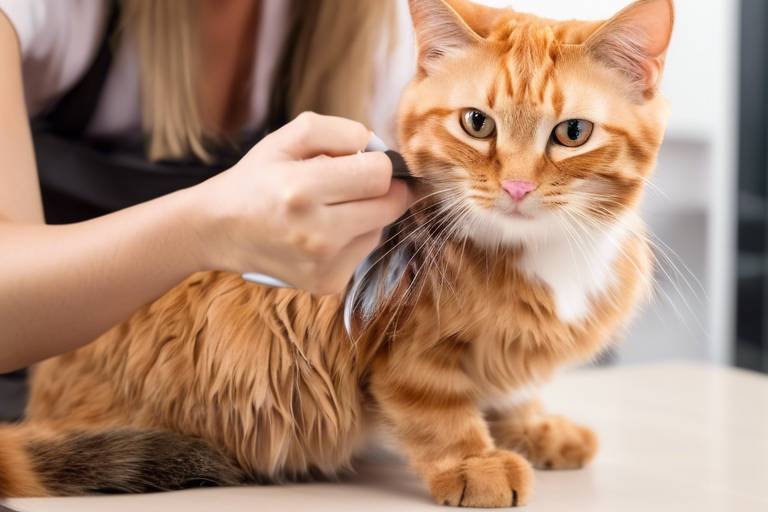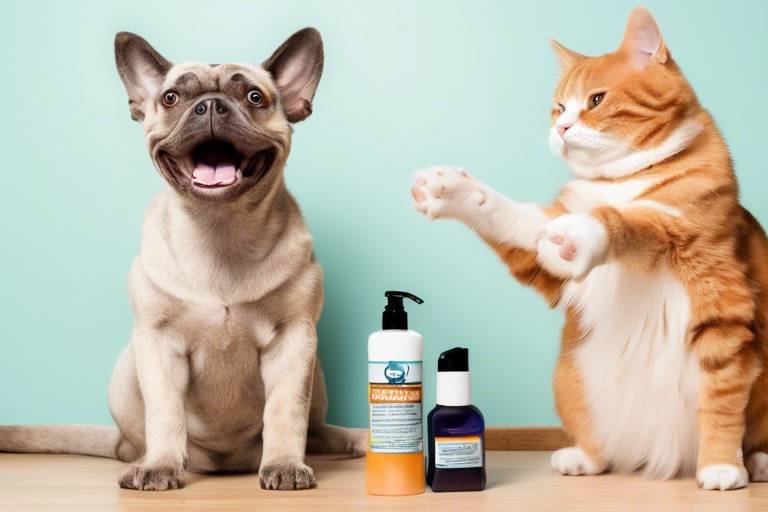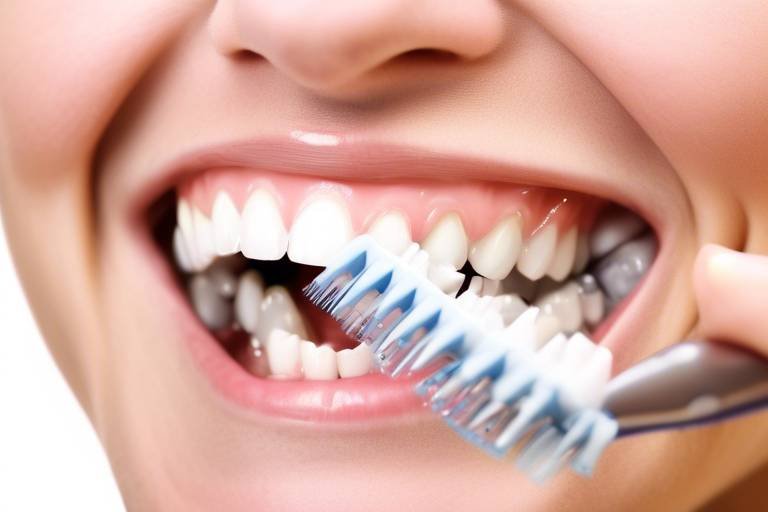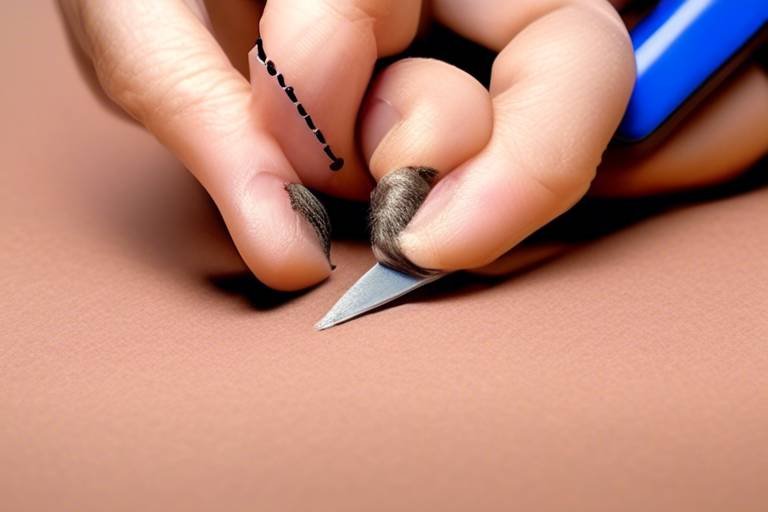Tips for Dealing with Shedding Season
Shedding season can feel like a furry apocalypse, can't it? One moment your beloved pet is cuddling up to you, and the next, you're covered in a blanket of fur that seems to have a life of its own! But don’t worry; you’re not alone in this battle against the fluff. This article provides practical advice for pet owners on managing shedding season. Learn effective strategies to minimize fur loss and maintain a clean home while keeping your pets comfortable. With the right approach, you can turn this seasonal challenge into a manageable part of pet ownership.
First things first, let's talk about shedding. It’s a completely natural process that all pets go through, influenced by factors like breed, health, and environment. Just like how we change our wardrobes with the seasons, pets shed their fur to adapt to temperature changes, hormonal shifts, and even stress. Recognizing the reasons behind shedding can help you better prepare for this seasonal challenge. For instance, some breeds shed more than others, and understanding your pet’s specific needs can make all the difference. So, before you panic about the fur flying around your house, take a moment to understand what’s going on with your furry friend.
Now that you’re in the know about shedding, let’s dive into some grooming techniques that can save your sanity. Regular grooming is essential during shedding season. Not only does it help remove loose fur, but it also keeps your pet’s coat healthy and shiny. Think of grooming as a spa day for your pet; they’ll love the attention, and you’ll love the lack of hair on your furniture!
Different brushes serve different purposes. It’s like choosing the right tool for a job; using the wrong one can lead to frustration. For instance, if your pet has a thick coat, a slicker brush can help remove mats and tangles, while a bristle brush is perfect for short-haired breeds. Here’s a quick guide to help you choose:
| Coat Type | Best Brush Type |
|---|---|
| Long-haired | Slicker Brush |
| Short-haired | Bristle Brush |
| Curly-haired | Comb |
Using the right brush can make your grooming sessions more effective and enjoyable for both you and your pet.
When it comes to tackling excessive shedding, deshedding tools are your best friends. These tools are designed specifically to remove the undercoat, which is often the culprit behind the fur explosion in your home. Brands like Furminator and Hertzko offer some fantastic options. Just remember to follow the instructions carefully to avoid irritating your pet’s skin. A little goes a long way, so use them sparingly but effectively!
Bathing your pet can also help remove loose fur. However, you want to ensure you’re not irritating their skin in the process. Use a gentle shampoo designed for pets, and make sure to rinse thoroughly. Bathing too frequently can strip natural oils from their coat, so aim for once every few weeks during shedding season. This not only keeps your pet clean but also reduces the amount of fur floating around your home.
Understanding how often to groom your pet during shedding season is crucial. Depending on your pet’s shedding patterns, you might find that daily brushing is necessary for some and weekly for others. Pay attention to your pet’s coat and adjust your grooming schedule accordingly. Regular grooming can significantly reduce the amount of fur you find on your clothes and furniture.
Nutrition plays a vital role in your pet’s coat health. Just like we need a balanced diet to look our best, so do our furry companions. Explore dietary adjustments that can help reduce shedding and promote a healthier fur coat. Incorporating essential fatty acids into your pet's diet can improve coat health. These nutrients help keep the skin moisturized and reduce excessive shedding. Foods rich in omega-3 and omega-6 fatty acids, such as fish oil and flaxseed, can work wonders.
Incorporating essential fatty acids into your pet's diet can significantly improve coat health. Consider adding fish oil or flaxseed oil to their meals. Not only will it help reduce shedding, but it will also give their coat that luscious shine we all adore. Just be sure to consult with your vet before making any significant changes to your pet's diet!
Proper hydration and a balanced diet are essential for minimizing shedding. Make sure your pet has access to clean, fresh water at all times. A well-hydrated pet is a happy pet, and it reflects in their coat. Additionally, a high-quality diet rich in proteins, vitamins, and minerals will support overall health and reduce shedding. You wouldn’t want to wear a sweater made from old, shed fur, would you? Neither does your pet!
Managing shedding also involves keeping your home clean. After all, a tidy living space can help alleviate some of the stress that comes with pet ownership. Here are some practical home maintenance tips to reduce pet hair accumulation and maintain a tidy living space.
Effective vacuuming techniques can significantly reduce pet hair in your home. Invest in a vacuum cleaner designed for pet hair; these machines often come with specialized attachments to tackle fur on various surfaces. Make it a routine to vacuum frequently, especially during shedding season. Don’t forget to vacuum your furniture and any areas where your pet likes to hang out!
Lint rollers and furniture covers are handy tools for quick cleanups. Keep a lint roller near your couch or your car to catch any stray hairs before they become a permanent fixture. Furniture covers can also protect your upholstery from fur and are easy to wash. It’s like giving your furniture a protective shield against the furry onslaught!
- How often should I groom my pet during shedding season?
It varies by breed, but daily to weekly grooming is often recommended. - Can diet really affect shedding?
Absolutely! A balanced diet with essential fatty acids can improve coat health and reduce shedding. - What tools should I use for deshedding?
Look for deshedding tools like the Furminator, which are designed to effectively remove loose fur. - Is it okay to bathe my pet frequently during shedding season?
Bathing every few weeks is sufficient; too much can irritate their skin.

Understanding Shedding
Shedding is a completely natural process that occurs in pets, and it can often feel like a furry storm has taken over your home. But why does this happen? Shedding is influenced by several factors, including your pet's breed, overall health, and the environment they live in. For instance, some breeds are notorious for shedding more than others. Think of it like a seasonal wardrobe change—some pets just have a more dramatic style! Understanding the reasons behind shedding can help you better prepare for this seasonal challenge.
During certain times of the year, particularly in spring and fall, pets may shed more fur as they transition between their winter and summer coats. This is often referred to as seasonal shedding. It’s almost like your pet is getting ready for a fashion show, swapping out their heavy winter coat for something lighter. However, if your pet is shedding excessively throughout the year, it might be a sign of underlying health issues or stress. Just like us, pets can experience changes in their bodies that affect their fur. It’s essential to monitor your pet’s shedding patterns closely.
Additionally, environmental factors play a significant role in shedding. For example, pets living in warmer climates may shed more frequently to regulate their body temperature. If your home is heated or air-conditioned, these temperature fluctuations can also trigger shedding. Here’s a quick breakdown of the main factors affecting shedding:
- Breed: Some breeds are known for their heavy shedding, while others are considered hypoallergenic.
- Health: Skin conditions, allergies, and parasites can lead to increased shedding.
- Environment: Changes in temperature, humidity, and even stress levels can impact shedding.
By understanding these factors, you can take proactive measures to manage shedding and keep your home clean. For example, if you notice your pet is shedding more than usual, it might be time for a trip to the vet to rule out any health concerns. Remember, your pet’s coat is not just about looks—it’s a reflection of their overall health and well-being.
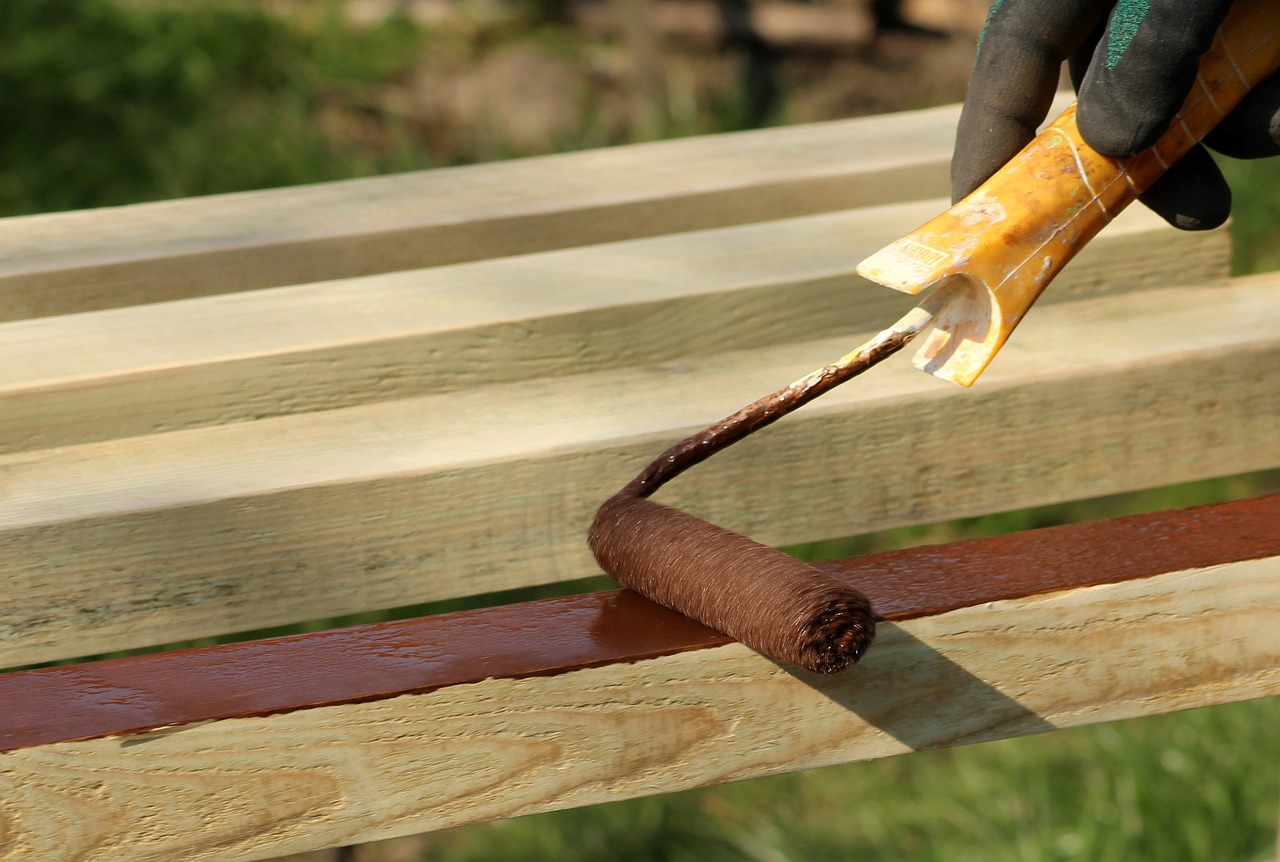
Grooming Techniques
When it comes to managing shedding season, are your best friends. Regular grooming not only helps reduce the amount of fur that ends up on your furniture and clothes but also keeps your pet's coat healthy and shiny. Think of grooming as a bonding time with your furry friend, a way to show them love while tackling that pesky fur problem. So, what are the best methods and tools to use during this shedding frenzy? Let’s dive into the essentials!
First off, let’s talk about brushing tools. Different brushes serve different purposes, and knowing which one to use can make a world of difference. For instance, slicker brushes are fantastic for removing loose hair and tangles, especially in long-haired breeds. On the other hand, bristle brushes work wonders for short-haired pets, distributing natural oils and giving their coat that glossy finish. If you’re unsure which brush is best for your pet’s coat type, here’s a quick guide:
| Coat Type | Recommended Brush |
|---|---|
| Short Hair | Bristle Brush |
| Medium Hair | Slicker Brush |
| Long Hair | Pin Brush |
Next, we have deshedding tools. These specialized tools are designed to tackle excessive shedding head-on. Products like the Furminator or other deshedding combs can significantly reduce the volume of hair your pet sheds. When using these tools, it’s important to follow the manufacturer’s instructions to avoid irritating your pet’s skin. A gentle touch goes a long way, and your pet will appreciate the care.
Bathing your pet is another effective technique for managing shedding. While it may seem counterintuitive, a good bath can help remove loose fur and dirt. However, it’s crucial to choose the right shampoo—opt for a gentle formula that won’t irritate your pet’s skin. During shedding season, bathing your pet every few weeks can help keep the fur situation under control. Just remember to dry them thoroughly afterward; a damp coat can lead to skin issues.
Now, you might be wondering how often you should groom your pet during shedding season. The frequency can vary based on your pet's breed and individual shedding patterns. Generally, a good rule of thumb is to brush your pet at least two to three times a week, and more often if they are heavy shedders. Consistency is key! Keeping a grooming schedule not only helps manage shedding but also allows you to monitor your pet's skin and coat condition.
In conclusion, mastering grooming techniques is essential for pet owners during shedding season. By using the right tools and maintaining a regular grooming routine, you can significantly reduce the amount of fur in your home while keeping your furry friend comfortable and happy. So grab those brushes, and let’s make shedding season a breeze!
Q: How often should I groom my pet during shedding season?
A: It's recommended to groom your pet at least two to three times a week, or more frequently if they are heavy shedders.
Q: What type of brush is best for my pet?
A: The best brush depends on your pet's coat type. Use a bristle brush for short-haired pets, a slicker brush for medium-haired pets, and a pin brush for long-haired pets.
Q: Can bathing my pet help with shedding?
A: Yes, bathing your pet can help remove loose fur and dirt. Just make sure to use a gentle shampoo and dry them thoroughly afterward.
Brushing Tools
When it comes to managing shedding season, having the right can make all the difference. Just like a painter needs the right brushes to create a masterpiece, pet owners need to equip themselves with the right grooming tools to keep their furry friends looking their best. Each pet, whether it's a fluffy golden retriever or a sleek short-haired cat, has unique grooming needs based on their coat type. Understanding these needs is crucial for effective grooming and minimizing shedding.
There are several types of brushes available, each designed for specific coat types and shedding challenges. For instance, if your pet has a long, flowing coat, a pin brush is ideal for detangling and removing loose fur. On the other hand, if you're dealing with a short-haired breed, a bristle brush will help remove dirt and distribute natural oils, keeping the coat shiny and healthy. It’s essential to choose a brush that suits your pet’s coat type to ensure effective grooming.
To help you navigate the world of brushing tools, here’s a quick overview of some popular options:
| Brush Type | Best For | Benefits |
|---|---|---|
| Pin Brush | Long-haired breeds | Detangles and removes loose fur |
| Bristle Brush | Short-haired breeds | Distributes natural oils, adds shine |
| Slicker Brush | All coat types | Removes mats and tangles, effective for shedding |
| Rubber Brush | Short-haired breeds | Gently removes hair and dirt, great for sensitive skin |
In addition to these brushes, deshedding tools are a game changer during shedding season. These tools are specifically designed to reach the undercoat and remove loose fur without damaging the top layer. Brands like FURminator and Hertzko offer effective solutions that can significantly reduce shedding when used regularly. It’s like having a secret weapon in your grooming arsenal!
But remember, the key to successful brushing is not just the tools you use, but also the technique. Always brush in the direction of hair growth to avoid pulling on your pet’s skin, which can be uncomfortable. And don’t forget to reward your pet with treats and praise during grooming sessions to create a positive experience. After all, a happy pet is more likely to cooperate during brushing!
In conclusion, investing in the right brushing tools and techniques can transform your shedding season experience from a fur-filled nightmare to a manageable routine. By understanding your pet’s grooming needs and using the appropriate tools, you can keep your home cleaner and your pet more comfortable. So, gear up and get ready to tackle those tufts of fur!
- How often should I brush my pet during shedding season? It depends on the breed and coat type, but generally, brushing several times a week is recommended for long-haired breeds and once a week for short-haired breeds.
- Can I use human brushes on my pet? It's best to use brushes specifically designed for pets, as human brushes may not be effective and could irritate your pet's skin.
- What should I do if my pet hates being brushed? Start slowly, use treats, and try to make it a positive experience. Short, frequent sessions can help your pet get used to the process.
Deshedding Tools
When it comes to managing shedding season, are your best friends. These specialized grooming devices are designed to tackle the excessive fur that seems to float around your home like confetti during a party. Whether you have a fluffy Golden Retriever or a sleek Siamese cat, there's a deshedding tool out there that can help you keep your pet’s coat in check while ensuring your living space remains fur-free.
One of the most popular deshedding tools is the deshedding brush. Unlike regular brushes, which may only remove surface hair, deshedding brushes penetrate deeper into your pet's coat to grab those loose undercoats that are ready to be shed. Brands like Furminator and Hertzko have made a name for themselves by creating brushes that are not only effective but also comfortable for your pet. Using these brushes regularly can drastically reduce the amount of fur that ends up on your floors and furniture.
Another effective tool is the deshedding comb. These combs are perfect for long-haired pets, as they can help detangle knots while simultaneously removing loose fur. The teeth of a deshedding comb are designed to glide through your pet's coat without pulling or causing discomfort. Using a comb after brushing can catch any remaining loose hairs, ensuring you’ve done a thorough job.
For those particularly hairy pets, you might also want to consider a deshedding tool with a blade. These tools feature a stainless steel blade that effectively removes loose fur without damaging the healthy hair. They come in various sizes, making them suitable for pets of all sizes, from tiny Chihuahuas to large Bernese Mountain Dogs. Just be sure to follow the manufacturer’s instructions to avoid overdoing it, as too much deshedding can lead to skin irritation.
When using deshedding tools, it's essential to establish a routine. Aim to deshed your pet at least once a week during shedding season, and increase the frequency if you notice a lot of fur around your home. The process should be enjoyable for your pet, so always reward them with treats and praise after grooming sessions. This not only makes grooming a positive experience but also helps reinforce the bond between you and your furry friend.
In summary, investing in the right deshedding tools can make a world of difference during shedding season. Not only will these tools help keep your home cleaner, but they will also contribute to your pet's overall coat health. Remember, a well-groomed pet is a happy pet!
- How often should I use deshedding tools? It’s recommended to use deshedding tools at least once a week during shedding season, but more frequent sessions may be necessary for heavy shedders.
- Can deshedding tools hurt my pet? When used correctly, deshedding tools should not hurt your pet. Always follow the manufacturer’s instructions and be gentle during grooming.
- Are there specific deshedding tools for different breeds? Yes, different breeds may require specific types of deshedding tools. Research the best options for your pet’s coat type for optimal results.
Bathing Tips
Bathing your pet during shedding season is not just about keeping them clean; it's a crucial step in managing that avalanche of fur that seems to take over your home. But how do you ensure that bath time is both effective and comfortable for your furry friend? First off, timing is everything. Choose a day when your pet is calm, preferably after a long walk or play session, when they are more likely to relax in the tub. This can make the entire experience smoother for both of you.
Next, consider the temperature of the water. Pets, much like humans, appreciate a warm bath, but it shouldn't be scalding. Aim for lukewarm water, which is gentle on their skin and helps to open up the hair follicles, making it easier to wash away loose fur. As you prepare for bath time, gather all your supplies ahead of time. This includes pet shampoo (preferably one designed for their coat type), towels, and a brush. Having everything within reach will make the process more efficient and less stressful.
When it comes to shampoo selection, opt for a product that is free from harsh chemicals and specifically formulated for pets. Human shampoos can disrupt their skin's natural oils and lead to irritation. If your pet has sensitive skin, you might want to consult your veterinarian for recommendations. Additionally, consider using a shampoo with added conditioners to help maintain their coat's shine and softness.
As you start bathing your pet, be gentle. Use your hands or a cup to pour water over their body, avoiding their face initially. This can help prevent panic and make them feel more secure. Once their coat is wet, apply the shampoo and work it into a lather, massaging it into their skin. This not only cleans but also stimulates the skin, promoting circulation. Pay special attention to areas where dirt and loose fur tend to accumulate, such as the belly, underarms, and behind the ears.
After rinsing thoroughly—because leftover shampoo can cause skin irritation—it's time to dry your pet. Use a towel to gently pat them dry, avoiding vigorous rubbing that could tangle their fur. If your pet tolerates it, you can use a blow dryer on a low setting, keeping it at a safe distance. Remember, the goal is to keep them comfortable throughout the process.
Lastly, consider the aftermath. After the bath, you might notice even more loose fur coming off as their coat dries. This is a great time to brush them out thoroughly. Not only does this help to remove additional shedding fur, but it also keeps their coat looking healthy and shiny. Plus, it reinforces the idea that bath time is followed by something pleasant—like a good brushing session!
In summary, bathing your pet during shedding season can be a game changer. With the right approach, you can turn what might seem like a chore into a bonding experience. So, gather your supplies, pick the right time, and remember to keep it gentle and enjoyable for your furry companion!
- How often should I bathe my pet during shedding season? It typically depends on your pet's breed and coat type, but generally, bathing every 4-6 weeks can help manage shedding effectively.
- Can I use human shampoo on my pet? No, it's best to use a shampoo specifically formulated for pets to avoid skin irritation.
- What should I do if my pet hates baths? Try to make bath time a positive experience with treats and praise. You can also consider using a shower sprayer or a tub with a non-slip mat for comfort.
Frequency of Grooming
When it comes to managing shedding season, understanding the is crucial for both your pet's comfort and your home's cleanliness. Just like we might change our wardrobe with the seasons, our pets also experience changes that require adjustments in their grooming routines. So, how often should you groom your furry friend during this time? The answer isn't one-size-fits-all; it varies based on several factors, including your pet's breed, coat type, and individual shedding patterns.
For instance, short-haired breeds may require less frequent grooming compared to long-haired ones. However, even short-haired pets can benefit from regular brushing to minimize the amount of loose fur that ends up on your floors and furniture. As a general rule of thumb, brushing your pet at least once a week is a good starting point, but during shedding season, you might want to step it up to every other day or even daily for more fur-heavy breeds.
To help you gauge the ideal grooming frequency, consider the following factors:
- Breed: Some breeds are notorious for heavy shedding, while others shed minimally. Research your pet's breed to understand its specific grooming needs.
- Coat Type: Long-haired pets often require more frequent grooming to prevent matting and tangles, while short-haired pets may need less.
- Seasonal Changes: As temperatures change, your pet's shedding patterns can also shift, often increasing during spring and fall.
- Health Status: If your pet is experiencing health issues or stress, shedding may increase, necessitating more frequent grooming sessions.
Ultimately, the goal is to find a grooming schedule that works for both you and your pet. Pay attention to your pet's coat and skin condition; if you notice excessive shedding or skin irritation, it might be time to increase grooming sessions. Regular grooming not only helps manage shedding but also allows you to bond with your pet, making it a win-win situation!
Q: How can I tell if my pet needs more grooming?
A: If you notice an increase in loose fur around your home or if your pet's coat looks dull and unkempt, it might be time to increase grooming frequency.
Q: Is it possible to over-groom my pet?
A: Yes, over-grooming can irritate your pet's skin and cause discomfort. Always monitor your pet's response to grooming sessions and adjust as necessary.
Q: What tools should I use for grooming?
A: The best tools depend on your pet's coat type. Brushes, combs, and deshedding tools can all be effective. Consult your veterinarian or groomer for specific recommendations.

Nutritional Considerations
When it comes to managing shedding season, nutrition is a crucial factor that often gets overlooked. Just like humans, pets require a balanced diet to maintain their health, including the health of their skin and coat. A well-nourished pet is less likely to shed excessively, and that’s something every pet owner wants, right? Think of your pet's coat as a beautiful garden; without the right nutrients, it can quickly become overgrown and messy. So, let’s dig into how you can adjust your pet's diet to promote a healthier, shinier coat!
First off, let’s talk about essential fatty acids. These nutrients are like the magic potion for your pet's fur. They help to keep the skin moisturized and the coat shiny, which can significantly reduce shedding. You can find essential fatty acids in sources like fish oil, flaxseed oil, and even certain types of nuts. If you're wondering how to incorporate these into your pet's diet, consider adding a small amount of fish oil to their food or look for pet foods that list these oils among the top ingredients.
Next, hydration plays a vital role in your pet's overall health and can also influence shedding. Just like how we need to drink enough water to stay hydrated, pets do too! Make sure your furry friend always has access to fresh water. You might even consider investing in a pet water fountain, which many pets find more appealing than a bowl. A well-hydrated pet is less likely to experience dry skin, which can lead to increased shedding.
Now, let’s not forget about the importance of a balanced diet. A diet rich in vitamins and minerals will support your pet's coat health. Look for pet foods that contain high-quality proteins, as proteins are essential for hair growth. You might want to check the ingredient list on your pet's food and ensure it includes real meat as the first ingredient. Additionally, consider foods enriched with vitamins A, E, and biotin, which are known to support skin and coat health.
To give you a clearer picture, here’s a quick overview of some key nutrients and their benefits:
| Nutrient | Benefits |
|---|---|
| Essential Fatty Acids | Improve coat health, reduce shedding, and moisturize skin. |
| High-Quality Proteins | Support hair growth and overall health. |
| Vitamins A & E | Promote healthy skin and coat. |
| Biotin | Strengthens hair and reduces breakage. |
In conclusion, making thoughtful adjustments to your pet's diet can significantly impact their shedding during this challenging season. Remember, a healthy pet is a happy pet, and with the right nutrition, you can keep your furry friend comfortable while also minimizing the amount of fur in your home. So, stock up on those nutritious goodies, and watch your pet thrive!
- How often should I change my pet's diet during shedding season?
It's best to maintain a consistent diet, but you can supplement with fatty acids and hydration as needed. - Can I give my pet human food to help with shedding?
Some human foods are safe for pets, but always consult your vet before making changes. - What signs indicate my pet's diet is affecting their shedding?
Look for dry skin, excessive shedding, and a dull coat as potential indicators.
Essential Fatty Acids
When it comes to keeping your furry friend’s coat healthy and shiny, play a pivotal role. These nutrients are not just buzzwords in the pet care world; they are crucial for maintaining a vibrant coat and minimizing shedding. Think of essential fatty acids as the magic potion that nourishes your pet’s skin and fur from the inside out. They help to maintain the skin's moisture barrier, which can reduce flakiness and irritation that often accompanies shedding season.
So, what exactly are essential fatty acids? They are types of fats that your pet's body cannot produce on its own, meaning they need to be obtained through diet. The two main types of essential fatty acids are omega-3 and omega-6. Omega-3s are known for their anti-inflammatory properties, making them particularly beneficial for pets with skin sensitivities or allergies. On the other hand, omega-6 fatty acids contribute to a healthy skin barrier and overall coat condition.
Including these fatty acids in your pet's diet can lead to a noticeable difference in their coat health. You might be wondering how to incorporate them effectively. Here are some excellent sources of essential fatty acids that you can consider:
- Fish Oil: Rich in omega-3 fatty acids, fish oil can be an excellent addition to your pet's meals. Just a few drops can make a significant impact.
- Flaxseed Oil: This is another great source of omega-3s, perfect for pets who may not enjoy fish.
- Chicken Fat: A source of omega-6 fatty acids, chicken fat can enhance the flavor of your pet's food while also benefiting their coat.
- Salmon: Not only is it tasty, but salmon is packed with omega-3 fatty acids that promote skin and coat health.
When adding any new supplement or food to your pet's diet, it’s essential to consult with your veterinarian first. They can help you determine the right dosage and ensure it fits well with your pet's overall health plan. Remember, moderation is key! Too much of a good thing can lead to other health issues.
In conclusion, essential fatty acids are not just a dietary luxury; they are a necessity for promoting a healthy coat and reducing shedding in pets. By understanding their importance and incorporating them into your pet's diet, you can help your furry friend look and feel their best during shedding season and beyond.
Q1: How can I tell if my pet needs more essential fatty acids?
A1: Signs that your pet may need more essential fatty acids include dry, flaky skin, excessive shedding, and a dull coat. If you notice these symptoms, consider evaluating their diet.
Q2: Can I give my pet human fish oil supplements?
A2: While some human supplements may be safe, it’s best to use pet-specific formulations to ensure the correct dosage and avoid any harmful ingredients.
Q3: How long does it take to see improvements in my pet’s coat after adding essential fatty acids?
A3: You might start seeing improvements in as little as a few weeks, but for significant changes, it could take a couple of months of consistent supplementation.
Hydration and Diet
When it comes to managing your pet's shedding, hydration and a well-balanced diet are paramount. Just like humans, pets need to stay hydrated to maintain healthy skin and a shiny coat. Dehydration can lead to dry skin, which can exacerbate shedding. Make sure your furry friend has access to fresh, clean water at all times. You might be surprised to learn that some pets prefer running water, so consider investing in a pet water fountain to encourage them to drink more.
Now, let’s talk about diet. The food you provide plays a crucial role in the health of your pet's coat. A diet rich in essential fatty acids, such as Omega-3 and Omega-6, can significantly improve coat health and reduce shedding. These fatty acids help to maintain skin moisture and elasticity, which can prevent excessive fur loss. You can find these nutrients in fish oil, flaxseed oil, and certain types of fish like salmon. If you're not sure how to incorporate these into your pet's diet, consult with your veterinarian for tailored advice.
Additionally, a diet that includes high-quality protein is vital. Protein provides the building blocks for hair growth and overall skin health. Look for pet foods that list a high-quality protein source, like chicken, beef, or fish, as the first ingredient. Avoid foods with fillers and artificial ingredients, as they can lead to poor coat condition and increased shedding.
Here’s a quick overview of some dietary components that can help reduce shedding:
| Component | Benefits |
|---|---|
| Essential Fatty Acids | Improves skin hydration and coat shine |
| High-Quality Protein | Supports hair growth and skin health |
| Vitamins and Minerals | Promotes overall health and reduces shedding |
Lastly, don't underestimate the importance of hydration in your pet’s overall health. Ensure they are drinking enough water, especially if they are on a dry food diet. You might even consider adding wet food to their meals, which can provide additional moisture and nutrients. Keeping your pet hydrated and well-nourished will not only help reduce shedding but will also contribute to their overall well-being.
- How much water should my pet drink? - Generally, pets should drink about 1 ounce of water per pound of body weight each day. However, this can vary based on activity level and diet.
- Can I give my pet fish oil supplements? - Yes, fish oil can be beneficial, but always consult your vet for the right dosage and type suitable for your pet.
- What are the signs of dehydration in pets? - Look for signs like dry gums, lethargy, and loss of skin elasticity. If you suspect dehydration, contact your vet immediately.

Home Maintenance Tips
Managing shedding isn’t just about keeping your furry friend looking fabulous; it’s also about maintaining a clean and comfortable home. As any pet owner knows, during shedding season, it can feel like your pet is on a mission to cover every surface with fur. But fear not! With the right strategies and tools, you can keep your home tidy and reduce the amount of pet hair that accumulates. Let's dive into some practical home maintenance tips that can help you tackle this seasonal challenge.
First and foremost, let's talk about vacuuming strategies. A good vacuum cleaner can be your best friend during shedding season. Look for vacuum cleaners specifically designed for pet hair; these often come with powerful suction and specialized attachments to lift hair from carpets, upholstery, and even hard-to-reach corners. Regular vacuuming is essential, but it’s not just about frequency; it’s also about technique. For instance, using a vacuum with a rotating brush can help dislodge hair from carpets, while a flat attachment works wonders on furniture. Aim to vacuum at least twice a week during peak shedding times to keep your home fur-free.
Another handy tool in your arsenal is the trusty lint roller. These sticky sheets are perfect for quick clean-ups, especially when you have unexpected guests. Just roll it over your clothes or furniture, and watch the fur disappear! In addition to lint rollers, consider investing in furniture covers. These covers not only protect your furniture from pet hair but can also be easily washed, making them a practical solution for keeping your home looking pristine.
Don't forget about the importance of regular cleaning. Beyond vacuuming, it's wise to dust surfaces frequently. Pet hair can settle on shelves, electronics, and other surfaces, so using a microfiber cloth can help trap hair and allergens effectively. You might also want to consider using an air purifier; this can help reduce airborne pet dander and keep the air in your home fresh and clean.
Lastly, let's not overlook the significance of creating a designated pet area. Having a specific space for your pet can help contain shedding to one area of your home. Use washable blankets or mats in this space, which can easily be cleaned, and encourage your pet to relax there. This not only makes maintenance easier but also provides your pet with a cozy spot to call their own.
Q: How often should I vacuum during shedding season?
A: Ideally, you should vacuum at least twice a week, but if your pet sheds heavily, daily vacuuming may be necessary.
Q: What type of vacuum is best for pet hair?
A: Look for vacuums specifically designed for pet owners, which often feature powerful suction, rotating brushes, and specialized attachments.
Q: Are lint rollers effective for cleaning pet hair?
A: Yes! Lint rollers are great for quick clean-ups on clothing and furniture, making them a handy tool during shedding season.
Q: How can I reduce pet hair in my home?
A: Regular grooming, frequent vacuuming, using furniture covers, and maintaining a clean environment all contribute to reducing pet hair in your home.
Vacuuming Strategies
When it comes to managing pet hair during shedding season, effective vacuuming strategies can be a game changer. Imagine your vacuum as a trusty sidekick in the battle against fur! Not all vacuums are created equal, and choosing the right one can make a world of difference. Look for vacuums specifically designed for pet owners, as they often come with powerful suction and specialized attachments for tackling stubborn hair. Brands like Dyson and Shark have models that are particularly popular among pet parents.
One of the best strategies is to establish a regular vacuuming schedule. Think of it like brushing your teeth; the more consistent you are, the better the results! Aim to vacuum at least twice a week during shedding season, and more often if you have a particularly furry friend. This will help keep the hair from accumulating and becoming a more daunting task. Additionally, consider vacuuming in the direction of the fur growth to capture more hair effectively.
Another tip is to use the right attachments. Many vacuums come with a range of tools designed for different surfaces. For instance, a pet hair attachment is fantastic for upholstery and stairs, while a crevice tool can help you reach those pesky corners where hair likes to hide. Don't forget about your floors! If you have a mix of carpets and hard floors, a vacuum with adjustable settings will allow you to switch between surfaces effortlessly.
Additionally, consider investing in a vacuum with a HEPA filter. These filters trap allergens and dander, making your home not just cleaner but also healthier for you and your pets. If you're feeling adventurous, try vacuuming your pet's favorite resting spots regularly. This can help reduce the amount of hair that gets spread throughout your home.
Lastly, if you're using a traditional vacuum, try running a rubber squeegee over your carpets and furniture before vacuuming. The rubber will help gather pet hair into clumps, making it easier for your vacuum to pick up. It's a simple trick that can save you time and effort!
- How often should I vacuum during shedding season? It's recommended to vacuum at least twice a week, but more frequently for heavy shedders.
- Can I use a regular vacuum for pet hair? While you can, it's best to use a vacuum specifically designed for pet hair for optimal results.
- What are the best attachments for vacuuming pet hair? Look for a pet hair attachment, crevice tool, and upholstery brush to effectively tackle various surfaces.
- Do I need a special filter for pet hair? Yes, a HEPA filter is ideal as it traps allergens and dander, improving air quality in your home.
Lint Rollers and Furniture Covers
When it comes to tackling pet hair, lint rollers and furniture covers are your best friends! Imagine this: you’ve just spent time grooming your furry companion, and yet, somehow, it feels like your home is still a fur-filled jungle. That’s where these handy tools come into play. Lint rollers are perfect for quick clean-ups, allowing you to swiftly remove pet hair from your clothes, upholstery, and even car seats. With just a few swipes, you can reclaim your wardrobe from the clutches of shedding season!
But let’s not forget about furniture covers. These are a game changer, especially if you have a couch or chairs that your pet loves to lounge on. By draping furniture covers over your seating, you not only protect your furniture from hair but also from scratches and stains. It’s like giving your furniture a cozy blanket that’s easy to wash! Plus, they come in various styles and colors, so you can choose ones that match your decor while keeping your home looking neat and tidy.
Now, if you’re wondering how to best utilize these tools, here are some tips:
- For Lint Rollers: Always keep one handy in your bag or car. You never know when you’ll need a quick touch-up!
- For Furniture Covers: Choose washable covers to make cleaning a breeze. Just toss them in the wash, and they’re good as new.
In addition to these tools, consider investing in a pet-specific vacuum cleaner that can handle the extra fur. Some vacuums come with attachments designed for furniture, making it easier to keep your living space fur-free. Remember, managing shedding is not just about cleaning up; it’s about creating a comfortable environment for both you and your pet. By incorporating lint rollers and furniture covers into your routine, you’ll find that maintaining a clean home during shedding season becomes much more manageable.
Q: How often should I use a lint roller on my clothes?
A: It depends on how much your pet sheds and how often you wear clothes that attract fur. For heavy shedders, a quick roll before heading out can save you from embarrassment!
Q: Can furniture covers help with allergies?
A: Yes! Furniture covers can help reduce allergens by trapping pet hair and dander, making it easier to keep your home allergen-free.
Q: Are there specific types of lint rollers better suited for pet hair?
A: Absolutely! Look for lint rollers with stronger adhesive sheets designed specifically for pet hair. They tend to pick up fur more effectively.
Frequently Asked Questions
- Why do pets shed their fur?
Shedding is a natural process for pets, influenced by factors such as breed, health, and environmental changes. Most pets will shed more during seasonal changes, like spring and fall, as they transition between their winter and summer coats.
- How often should I groom my pet during shedding season?
The frequency of grooming depends on your pet's coat type and shedding pattern. Generally, during shedding season, you should aim to groom your pet at least 2-3 times a week to effectively manage loose fur and keep their coat healthy.
- What grooming tools are best for reducing shedding?
Different brushes serve different purposes. For example, slicker brushes are great for removing loose hair, while deshedding tools like the Furminator can help tackle excessive shedding. Choose tools based on your pet's coat type for optimal results.
- Can nutrition affect my pet's shedding?
Absolutely! A balanced diet rich in essential fatty acids can improve your pet's coat health and reduce shedding. Foods like fish oil, flaxseed, and high-quality pet food can make a significant difference.
- What are some effective home maintenance tips to manage pet hair?
Regular vacuuming with a pet-friendly vacuum cleaner can help keep your home fur-free. Additionally, using lint rollers and furniture covers can make quick cleanups a breeze and keep your living space tidy.
- How can I minimize shedding while bathing my pet?
Bathing your pet during shedding season can help remove loose fur. Use a gentle pet shampoo, and make sure to rinse thoroughly. After bathing, brushing your pet while their coat is damp can also help remove more loose hair.

